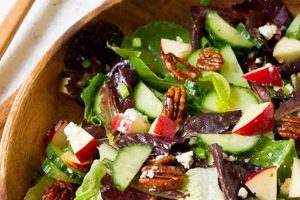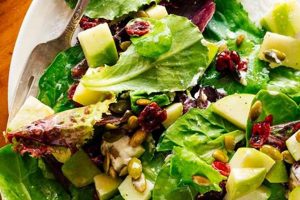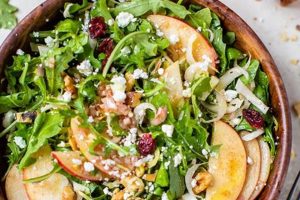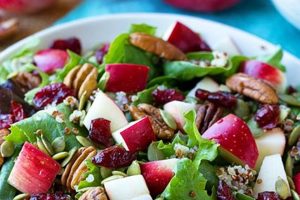Combinations of apple and pear in salads offer a refreshing blend of sweet and slightly tart flavors, complemented by varied textures. A typical preparation might include crisp apple slices, such as Honeycrisp or Granny Smith, paired with softer pear varieties like Bartlett or Bosc. These fruits are often combined with leafy greens, cheeses like blue cheese or goat cheese, and nuts such as walnuts or pecans. A light vinaigrette, perhaps featuring lemon juice, olive oil, and honey, typically completes the dish.
The nutritional value of such salads is significant, providing vitamins, minerals, and fiber. The contrasting textures and flavors make them appealing additions to meals, suitable as light lunches, side dishes, or parts of larger buffets. Historically, fruit salads have evolved from simple combinations of seasonal produce to more elaborate creations involving diverse ingredients and dressings. The pairing of apples and pears specifically reflects a desire to balance sweetness with a touch of acidity, creating a harmonious culinary experience.
Further exploration of this culinary theme could involve examining specific recipes, including variations in ingredients and dressings. Analysis of the nutritional benefits of specific apple and pear varieties, as well as complementary ingredients, could also provide valuable insights. Finally, a discussion of the historical and cultural contexts surrounding fruit salads in various cuisines would offer a broader perspective.
Tips for Crafting Exceptional Apple and Pear Salads
Achieving optimal flavor and texture in an apple and pear salad requires attention to detail and an understanding of ingredient interactions. The following tips offer guidance for creating a successful and enjoyable dish.
Tip 1: Select complementary apple and pear varieties. Balance sweetness and tartness by combining a crisp, tart apple like Granny Smith with a sweeter pear such as Bartlett. Alternatively, pair a sweeter apple like Honeycrisp with a firmer, slightly tart pear like Anjou.
Tip 2: Prevent browning. To maintain the appealing appearance of sliced apples and pears, toss them with a small amount of lemon juice immediately after cutting. This inhibits enzymatic browning.
Tip 3: Consider texture. Incorporate ingredients that provide textural contrast. Toasted nuts, crumbled cheese, or seeds offer satisfying crunch against the softer fruit.
Tip 4: Enhance the flavor profile. Experiment with different cheeses, such as blue cheese, goat cheese, or feta, to complement the sweetness of the fruit. Nuts like walnuts, pecans, or almonds can also add depth of flavor.
Tip 5: Choose an appropriate dressing. A light vinaigrette with a touch of sweetness or acidity best complements the delicate flavors of apple and pear. Consider using ingredients like honey, lemon juice, or balsamic vinegar.
Tip 6: Add leafy greens. Baby spinach, arugula, or mixed greens provide a bed of freshness and contribute additional nutrients.
Tip 7: Time the addition of dressing. To prevent the salad from becoming soggy, dress it just before serving.
By following these guidelines, one can elevate a simple apple and pear salad into a sophisticated and flavorful dish that offers both nutritional value and culinary satisfaction.
These tips provide a starting point for exploring the versatility of apple and pear salads. Experimentation and adaptation to individual preferences are encouraged.
1. Ingredient Selection
Ingredient selection significantly impacts the final quality of an apple pear salad. The variety of apple and pear chosen dictates the flavor profile, ranging from tart to sweet. Texture also varies; some apples maintain a crispness while others offer a softer bite. Pears similarly range from firm to buttery. Consideration of these factors allows for the creation of a balanced and nuanced salad. For instance, a crisp Granny Smith apple paired with a ripe Bartlett pear creates a contrast in both flavor and texture. Conversely, combining a Honeycrisp apple with a soft Comice pear emphasizes sweetness and a smooth mouthfeel. Beyond the core fruits, other ingredients must be carefully selected. Cheeses, nuts, and leafy greens each contribute to the overall composition. A sharp blue cheese provides a pungent counterpoint to the fruit’s sweetness, while a milder goat cheese offers a creamier complement. Nuts, such as walnuts or pecans, introduce textural complexity and earthy notes. Leafy greens, like spinach or arugula, contribute freshness and visual appeal. Each ingredient plays a crucial role in the final product.
The interplay between ingredients extends beyond individual flavors and textures. The dressing chosen should harmonize with the other components. A vinaigrette with a touch of acidity can balance the sweetness of the fruit and enhance the other flavors. The quantity of each ingredient also affects the overall balance. Too much of one element can overwhelm the others, while too little may leave the salad lacking depth. A successful apple pear salad achieves a harmonious blend of flavors and textures, where each ingredient contributes to the overall experience without dominating the others. This careful orchestration of ingredients elevates the dish from a simple combination of fruits to a complex and satisfying culinary creation.
Ultimately, effective ingredient selection determines whether an apple pear salad is merely acceptable or truly exceptional. Understanding the characteristics of each component, from the sweetness of the fruit to the sharpness of the cheese, allows for informed choices that contribute to a balanced and flavorful salad. This knowledge enables the creation of a dish that is not only delicious but also visually appealing and nutritionally sound. The attention paid to ingredient selection reflects a commitment to culinary excellence and a dedication to providing a satisfying sensory experience.
2. Flavor Balance
Flavor balance represents a crucial element in a successful apple pear salad recipe. The inherent sweetness of both apples and pears necessitates careful consideration of counterbalancing elements. Overly sweet salads can become cloying, while insufficient sweetness can result in a bland, unappealing dish. Achieving this balance involves strategic selection of ingredients and dressings that complement the natural sugars of the fruit. Tartness, acidity, bitterness, saltiness, and umami can all play roles in creating a harmonious flavor profile. For example, the sharpness of a blue cheese or the tang of a vinaigrette effectively offsets the sweetness of ripe pears, preventing the salad from becoming overly saccharine. Conversely, a touch of honey in the dressing can enhance the natural sweetness of tart apples, adding depth and complexity.
The interplay of flavors extends beyond simple counterbalance. Textural elements also contribute to the overall perception of flavor. A crisp apple provides a different sensory experience than a soft pear, and these textural variations interact with the taste receptors. The addition of crunchy nuts or creamy cheese further complicates and enriches the flavor profile. Moreover, the intensity of flavors must be considered. A strongly flavored cheese, such as Roquefort, can easily overpower the delicate sweetness of a pear, while a mild feta allows the fruit’s flavor to shine through. A successful apple pear salad recipe carefully calibrates these elements, ensuring that no single flavor dominates but rather contributes to a well-integrated whole. This attention to detail elevates the salad from a simple combination of ingredients to a nuanced culinary experience.
Mastering flavor balance in an apple pear salad requires both understanding of taste principles and practical experimentation. Recognizing the interplay of sweet, tart, and savory elements provides a foundation for ingredient selection and dressing development. However, individual palates vary, and achieving the ideal balance often involves adjusting proportions and exploring different flavor combinations. The ultimate goal is to create a salad that is both refreshing and satisfying, where the sweetness of the fruit is harmoniously integrated with complementary flavors and textures. This careful orchestration of taste and texture transforms a basic apple pear salad into a truly exceptional dish.
3. Texture Contrast
Texture contrast significantly contributes to the sensory experience of consuming an apple pear salad. A successful recipe considers and incorporates a variety of textures to create a more dynamic and enjoyable dish. Balancing the inherent textures of the apples and pears with complementary ingredients elevates the salad beyond a simple combination of fruits.
- Fruit Firmness and Ripeness
Apples and pears offer a spectrum of textures depending on variety and ripeness. A crisp, firm apple like a Granny Smith contrasts with a softer, ripe pear like a Bartlett. Selecting fruits at different stages of ripeness contributes to textural complexity. This variation prevents monotony and provides a more stimulating eating experience.
- Incorporating Nuts and Seeds
Nuts and seeds introduce a crucial element of crunch. Options such as walnuts, pecans, almonds, or sunflower seeds provide a textural counterpoint to the softer fruits. Toasting the nuts enhances their inherent crispness and adds a layer of flavor. The contrast between the smooth fruit and the crunchy nuts creates a more satisfying mouthfeel.
- The Role of Cheeses
Crumbled cheeses contribute both flavor and textural variation. A firm, salty cheese like feta provides a crumbly contrast, while a softer cheese such as goat cheese adds a creamy element. The interplay of these textures with the fruits and nuts creates a multi-faceted sensory experience. The choice of cheese should complement the overall flavor profile of the salad while also enhancing its textural complexity.
- Leafy Green Selection
Leafy greens contribute more than just visual appeal; they also offer textural diversity. Crisp romaine lettuce provides a sturdy base, while delicate spinach adds a softer touch. Arugula offers a slightly peppery flavor and a tender yet substantial texture. The choice of greens contributes to the overall balance and complexity of the salad.
The strategic combination of these textural elements transforms a simple apple pear salad into a more engaging culinary experience. The interplay of crispness, softness, creaminess, and crunch creates a dynamic mouthfeel that elevates the dish beyond its individual components. Attention to texture contrast demonstrates a commitment to culinary excellence and enhances the overall enjoyment of the salad.
4. Dressing Choice
Dressing choice significantly influences the overall flavor profile and enjoyment of an apple pear salad. The dressing acts as a unifying element, binding the ingredients together and enhancing their individual characteristics. A well-chosen dressing complements the natural sweetness of the fruits while adding depth and complexity. Conversely, an inappropriate dressing can mask the delicate flavors of the apples and pears, resulting in a less satisfying culinary experience. Careful consideration of flavor pairings and textural impact is essential when selecting a dressing.
- Acidity and Sweetness
Balancing acidity and sweetness is paramount. Vinaigrettes, often based on vinegar or citrus juice, provide the necessary acidity to cut through the sweetness of the fruit. A touch of sweetness, achieved through honey, maple syrup, or a fruit-based reduction, can further enhance the flavor profile. The ratio of acidity to sweetness depends on the specific types of apples and pears used, as well as other ingredients in the salad. A tart Granny Smith apple may benefit from a slightly sweeter dressing, while a ripe Bartlett pear might require a more acidic counterpoint. Balancing these elements ensures the dressing complements rather than overwhelms the fruit.
- Oil Selection
The choice of oil in a vinaigrette contributes to both flavor and texture. Extra virgin olive oil offers a robust flavor that complements many ingredients, while a lighter oil like grapeseed or avocado oil provides a more neutral base. Nut oils, such as walnut or hazelnut oil, can introduce subtle nutty notes that enhance the overall flavor profile. The oil’s viscosity also plays a role; a thicker oil will cling to the ingredients more readily, while a thinner oil provides a lighter coating. The oil selection should harmonize with the other dressing components and the overall composition of the salad.
- Flavor Enhancements
Incorporating additional flavor elements into the dressing further expands the possibilities. Fresh herbs, such as mint, basil, or tarragon, can add brightness and complexity. Spices, like cinnamon or ginger, introduce warmth and depth. A touch of Dijon mustard adds a subtle tang and helps emulsify the dressing. These additions should be used judiciously to avoid overpowering the delicate flavors of the apples and pears. The goal is to create a dressing that enhances, rather than masks, the natural flavors of the salad.
- Creamy Dressings
While vinaigrettes are a common choice, creamy dressings can also complement apple pear salads, particularly those with richer ingredients like cheese and nuts. A yogurt-based dressing, perhaps flavored with herbs or spices, offers a lighter alternative to mayonnaise-based dressings. The creamy texture provides a contrast to the crispness of the fruit, while the tangy flavor balances the sweetness. However, it’s important to choose creamy dressings carefully, as they can easily overpower the delicate flavors of the fruit if too heavy or rich.
Ultimately, the ideal dressing for an apple pear salad depends on the specific ingredients used and the desired flavor profile. The interplay of acidity, sweetness, oil, and additional flavor elements determines the final result. A thoughtfully chosen dressing elevates the salad, transforming it from a simple combination of ingredients into a harmonious and flavorful dish. Careful consideration of these factors ensures that the dressing complements the apples and pears, enhancing their natural sweetness and creating a balanced and enjoyable culinary experience.
5. Presentation
Presentation plays a significant role in the overall enjoyment of an apple pear salad. While flavor and texture are paramount, visual appeal enhances the dining experience. A thoughtfully presented salad is more appetizing, encouraging consumption and contributing to a more positive perception of the dish. Consideration of color, shape, and arrangement elevates the salad from a simple mixture of ingredients to a visually engaging culinary creation. For example, arranging the sliced apples and pears in an overlapping pattern on a bed of greens creates a more visually appealing presentation than simply tossing all the ingredients together. Garnishing the salad with a sprinkle of chopped nuts or a few sprigs of fresh herbs further enhances its visual appeal. The use of contrasting colors, such as red-skinned apples against green pears and dark leafy greens, creates a visually dynamic composition.
The choice of serving vessel also contributes to the presentation. A shallow bowl or platter allows for a more artistic arrangement of the ingredients, showcasing their colors and textures. Individual portions served in smaller bowls or on plates offer a more elegant presentation, particularly for formal occasions. The use of appropriate serving utensils, such as tongs or individual forks, further enhances the dining experience. Beyond the arrangement of ingredients, attention to detail extends to the surrounding elements. A clean tablecloth, polished silverware, and appropriate glassware contribute to the overall ambiance and enhance the perception of the salad. These details demonstrate care and attention to the dining experience, elevating the perception of the salad beyond its inherent culinary value.
Effective presentation enhances the perceived value and enjoyment of an apple pear salad. A visually appealing salad stimulates the appetite and creates a more positive dining experience. While taste and texture remain crucial, presentation adds another layer of enjoyment, transforming a simple dish into a more memorable culinary creation. The attention to detail in presentation reflects a commitment to culinary excellence and enhances the overall appreciation of the salad. Careful consideration of color, arrangement, and serving elements ensures that the visual presentation complements the flavors and textures, creating a harmonious and satisfying dining experience.
6. Nutritional Value
Nutritional value represents a significant aspect of apple pear salad recipes. These salads offer a combination of vitamins, minerals, and dietary fiber contributing to overall health and well-being. Apples provide vitamin C, an antioxidant supporting immune function, and dietary fiber, promoting digestive health. Pears contribute vitamin K, essential for blood clotting, and potassium, an electrolyte crucial for maintaining fluid balance. The combined nutritional profile of apples and pears makes these salads a valuable addition to a balanced diet. For instance, incorporating an apple pear salad into a lunch routine provides a nutrient-rich meal option that can contribute to daily recommended intakes of essential vitamins and minerals. The fiber content promotes satiety, potentially aiding in weight management.
Furthermore, the nutritional value of these salads can be enhanced through the inclusion of other nutrient-dense ingredients. Adding nuts, such as walnuts or almonds, increases the salads’ healthy fat and protein content, contributing to satiety and providing essential fatty acids. Incorporating leafy greens, such as spinach or kale, further boosts vitamin and mineral intake. Moreover, the choice of dressing influences the nutritional composition. Opting for a vinaigrette made with olive oil provides monounsaturated fats, associated with cardiovascular health benefits. Conversely, creamy dressings may contain higher levels of saturated fat and added sugars, potentially negating some of the inherent health benefits of the fruits and vegetables. Understanding the nutritional contributions of each ingredient allows for informed choices that maximize the health benefits of the salad. Analyzing the nutritional content of different apple and pear varieties reveals further nuances. For example, Granny Smith apples generally offer higher levels of vitamin C than Red Delicious apples.
In conclusion, apple pear salads offer a range of nutritional benefits stemming from the inherent properties of the core ingredients. Careful selection of additional components, such as nuts, leafy greens, and dressings, further enhances the nutritional value. Understanding the nutritional composition of these salads empowers individuals to make informed dietary choices that contribute to overall health and well-being. Incorporating such salads into regular meal planning provides a readily accessible and palatable means of increasing fruit and vegetable consumption while contributing to the intake of essential vitamins, minerals, and fiber. However, individual dietary needs and health conditions necessitate tailored approaches; consulting a nutritionist or healthcare professional can provide personalized guidance on incorporating apple pear salads into a specific dietary plan.
Frequently Asked Questions
This section addresses common inquiries regarding apple and pear salad preparation and consumption.
Question 1: How can enzymatic browning of apples and pears be prevented after slicing?
Coating the sliced fruit with an acidic agent, such as lemon juice, immediately after cutting inhibits browning. This process slows the oxidation reaction responsible for discoloration.
Question 2: Which apple and pear varieties are best suited for salads?
Optimal choices depend on the desired balance of sweetness and tartness. Crisp apples like Granny Smith or Honeycrisp pair well with softer pears like Bartlett or Bosc. Experimentation with different varietals is encouraged.
Question 3: What dressings complement the flavors of apple and pear?
Light vinaigrettes featuring lemon juice, olive oil, and a touch of honey or maple syrup often complement these fruits. Creamy dressings, if used, should be light and not overly rich to avoid masking the delicate fruit flavors.
Question 4: How can textural interest be added to an apple pear salad?
Incorporating ingredients like toasted nuts (walnuts, pecans, almonds), seeds (sunflower, pumpkin), or crumbled cheese (blue cheese, feta, goat cheese) provides contrasting textures.
Question 5: How long can an apple pear salad be stored?
While best consumed fresh, an apple pear salad can be stored in an airtight container in the refrigerator for up to two days. Dressing the salad just before serving helps maintain optimal texture.
Question 6: Can apple and pear salads be part of a healthy diet?
These salads contribute valuable vitamins, minerals, and fiber. Nutritional content can be further enhanced by incorporating leafy greens and nutrient-rich additions. However, overall dietary context should be considered.
Understanding these aspects contributes to creating and enjoying high-quality apple and pear salads.
Further details on specific recipe variations and nutritional information can be explored in subsequent sections.
Apple Pear Salad Recipe
Exploration of apple pear salad recipes reveals a multifaceted culinary subject. Careful ingredient selection, balancing flavor profiles, achieving textural contrast, and thoughtful dressing choices contribute to a successful outcome. Presentation enhances the dining experience, while awareness of nutritional value underscores the health benefits. From the crisp bite of a Granny Smith apple to the smooth texture of a ripe Bosc pear, the interplay of flavors and textures offers a dynamic culinary experience.
The potential for variation within apple pear salad recipes remains vast. Continued exploration of ingredient combinations, dressing formulations, and presentation techniques offers opportunities for culinary innovation. Ultimately, the creation of an exceptional apple pear salad represents a harmonious balance of culinary art and nutritional awareness, contributing to both gustatory satisfaction and healthful eating practices.






